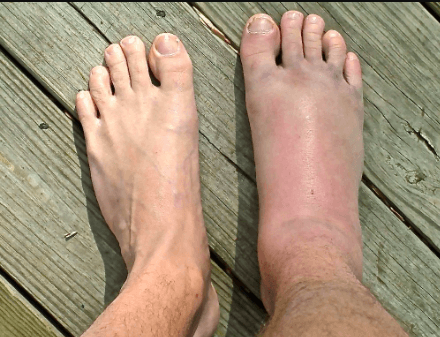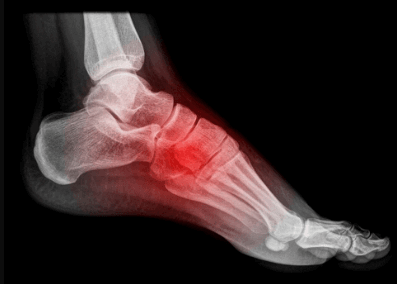What is a Sprained Foot?
Foot Is a sophisticated system of interconnected ligaments (strong, flexible and fibrous tissues that connect one bone to another) that connect the 28 bones of the foot.
These ligaments are essential for walking, running, jumping and all other activities that require bearing weight (standing). A sprain occurs when a ligament has been overly stretched or is partially or completely torn away from the bone.
The most common sprain occurs in the middle part of the foot (the part of the foot between the toe and the heel).

Causes
A sprained foot is most commonly caused by an injury to the foot. Such injury may occur in the form of a sufficiently heavy object falling on the foot. This crushing injury (even though the impact is on the top of the foot) can be forceful enough to cause the bones of the foot to spread out.
When the bones separate in this way, there is an unusual stress placed on the ligaments. If the ligaments are unable to stretch enough to absorb the force of the impact, they may tear away from the bones.
A foot sprain may be caused by a shearing force as the foot is twisted. Consider a ballet dancer who must stand on the ball of her foot or on her toes. As she moves through different ballet positions, her foot must remain stable on the floor as she twists her body in different directions.
Twisting her heel far enough away from the ball of the foot may cause ligaments to be pulled apart from the bone. Or a basketball player who, when jumping to make a basket doesn’t land squarely on her feet as she expected, causing her foot to twist with such force that ligaments become partially or completely detached from bones.
Symptoms
The hallmark symptom of a sprained foot is pain at the time of injury, that persists, especially when standing on the injured foot. Sometimes, a popping type of sensation can be felt when the injury happens. Pain is often accompanied by swelling as the body responds in an attempt to heal the injury.
With a severe enough injury, the small capillaries in the skin may break, causing bruising. Flexing the foot (bending the ankle so that the toes are pointing toward the head) reproduces the pain.

Diagnosis
The symptoms of foot sprain are enough to suspect the injury. However, other foot injuries, such as a strains, in which there is tearing or injury to a tendon or muscle, or fracture, in which one or more of the bones of the foot are broken, can produce similar symptoms.
The first test ordered is usually an X-ray, which is helpful in determining whether or not there are bones that are broken. X-rays do not diagnose sprains so much as they rule out the possibility of fracture. However, if abnormal separation of the bones is seen on X-ray, an inference may be made that a sprain has occurred.
Should there be any doubt about the type or extent of injury, an MRI (magnetic resonance imaging) may be ordered. MRIs do not use radiation, but instead use radio waves and magnetism to visualize body structures. Soft tissue injuries, like a sprain, will appear on an MRI image. These images are clear enough to diagnose not only the type of injury, but also the extent of the injury.

There are three grades of foot strain, which are important to differentiate because they require different treatment in order to heal well. They are as follows:
Grade 1
A small tear of the ligament from the bone such that the person is able to bear weight on the affected foot, but will have pain in doing so. This injury would prevent a person from doing higher impact activities such as running or jumping.
Grade 2
A large tear of the ligament from the bone such that the person is not able to bear weight on the affected foot without considerable pain.
Grade 3
A complete tear of the ligament from the bone such that weight-bearing causes pain and often instability.
Treatment
Grade 1 and many grade 2 strains can be treated without surgery. Resting, icing, compressing and elevating (RICE) the affected foot may be enough to promote healing.
NSAIDS (non-steroidal anti-inflammatory drugs) like ibuprofen and naproxen, can be taken to ease the symptoms of pain and swelling. If pain persists despite these measures, surgery may be recommended.
Some grade 2 strains and all grade 3 strains will only heal well with surgery. Depending on the extent and location of the strained ligament, percutaneous surgery (surgery done through a small puncture of the skin) may be possible. If the surgeon is unable to reattach the ligament to the bone percutaneously, an open procedure, involving a larger incision through the skin, will be necessary.
Grade 3 injuries require hardware – screw and plates – to affix the ligament to the bone. They will later be removed. Surgical complications may include foot stiffness and pain, and sometimes arthritis.
How Long Does it Take a Foot Sprain to Heal?
The duration required for a foot sprain to heal depends on the extent of the injury, and whether or not surgery is required. Minor sprains will heal on their own within a few weeks. More significant ligament tears heal best when the foot is immobilized.
Keeping weight off the foot is essential to avoid further separation of the bones, which can cause overstretching of the ligament and possibly, greater injury. Full tears that are surgically repaired take much longer to heal – often as long as six to eight months – during which physical therapy is recommended to stretch and strengthen the muscles and ligaments.
Prevention
Foot sprain can be prevented by:
- -wearing well fitting footwear appropriate to the activity
- -doing regular exercises that stretch the foot and strengthen the muscles of the foot
- -warming up prior to any athletic activity
References
- Sprained Foot – Dislocation and sprain of joints and ligaments at ankle, foot and toe level S93- >. (n.d.). Retrieved March 22, 2017, from http://www.icd10data.com/ICD10CM/Codes/S00-T88/S90-S99/S93-
- Fields, K. B. (2016, November 1). Evaluation and diagnosis of common causes of foot pain in adults. Retrieved March 22, 2017, from https://www.uptodate.com/
- Maughan, K. L. (2017, February 20). Ankle sprain. Retrieved March 22, 2017, from https://www.uptodate.com/contents/ankle-sprain?source=search_result&search=sprained ankle&selectedTitle=1~34
- Sprained Foot – Molly A, Selvan D. Ligamentous injuries of the foot and ankle. In: Miller MD, Thompson SR, eds. DeLee and Drez’s Orthopaedic Sports Medicine. 4th ed. Philadelphia, PA: Elsevier Saunders; 2015:chap 116.
